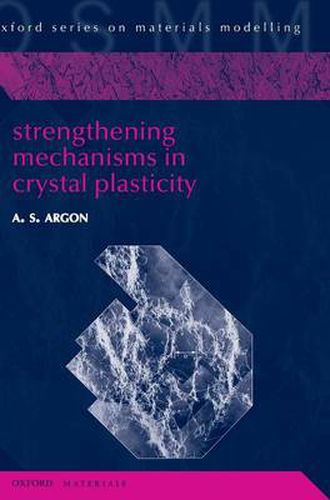Readings Newsletter
Become a Readings Member to make your shopping experience even easier.
Sign in or sign up for free!
You’re not far away from qualifying for FREE standard shipping within Australia
You’ve qualified for FREE standard shipping within Australia
The cart is loading…






The strengthening of metals by a variety of means has been of interest over much of history. However, the elucidation of the actual mechanisms involved in the processes of alloying and work hardening, and the related processes of metals as a scientific pursuit, has become possible only through the parallel developments in dislocation theory and in definitive experimental tools of electron microscopy and X-ray diffraction. The important developments over the past several decades in the mechanistic understanding of the often complex processes of interaction of dislocations with each other, with solute atoms and with precipitates during plastic flow have largely remained scattered in the professional literature. This has made it difficult for students and professionals to have ready access to this subject as a whole. While there are some excellent reviews of certain aspects of the subject, there is presently no single comprehensive coverage available of the central mechanisms and their modelling. The present book on Strengthening Mechanisms in Crystal Plasticity provides such a coverage in a generally transparent and readily understandable form. It is intended as an advanced text for graduate students in materials science and mechanical engineering. The central processes of strengthening that are presented are modeled by dislocation mechanics in detail and the results are compared extensively with the best available experimental information. The form of the coverage is intended to inspire students or professional practitioners in the field to develop their own models of similar or related phenomena and, finally, engage in more advanced computational simulations, guided by the book.
$9.00 standard shipping within Australia
FREE standard shipping within Australia for orders over $100.00
Express & International shipping calculated at checkout
The strengthening of metals by a variety of means has been of interest over much of history. However, the elucidation of the actual mechanisms involved in the processes of alloying and work hardening, and the related processes of metals as a scientific pursuit, has become possible only through the parallel developments in dislocation theory and in definitive experimental tools of electron microscopy and X-ray diffraction. The important developments over the past several decades in the mechanistic understanding of the often complex processes of interaction of dislocations with each other, with solute atoms and with precipitates during plastic flow have largely remained scattered in the professional literature. This has made it difficult for students and professionals to have ready access to this subject as a whole. While there are some excellent reviews of certain aspects of the subject, there is presently no single comprehensive coverage available of the central mechanisms and their modelling. The present book on Strengthening Mechanisms in Crystal Plasticity provides such a coverage in a generally transparent and readily understandable form. It is intended as an advanced text for graduate students in materials science and mechanical engineering. The central processes of strengthening that are presented are modeled by dislocation mechanics in detail and the results are compared extensively with the best available experimental information. The form of the coverage is intended to inspire students or professional practitioners in the field to develop their own models of similar or related phenomena and, finally, engage in more advanced computational simulations, guided by the book.